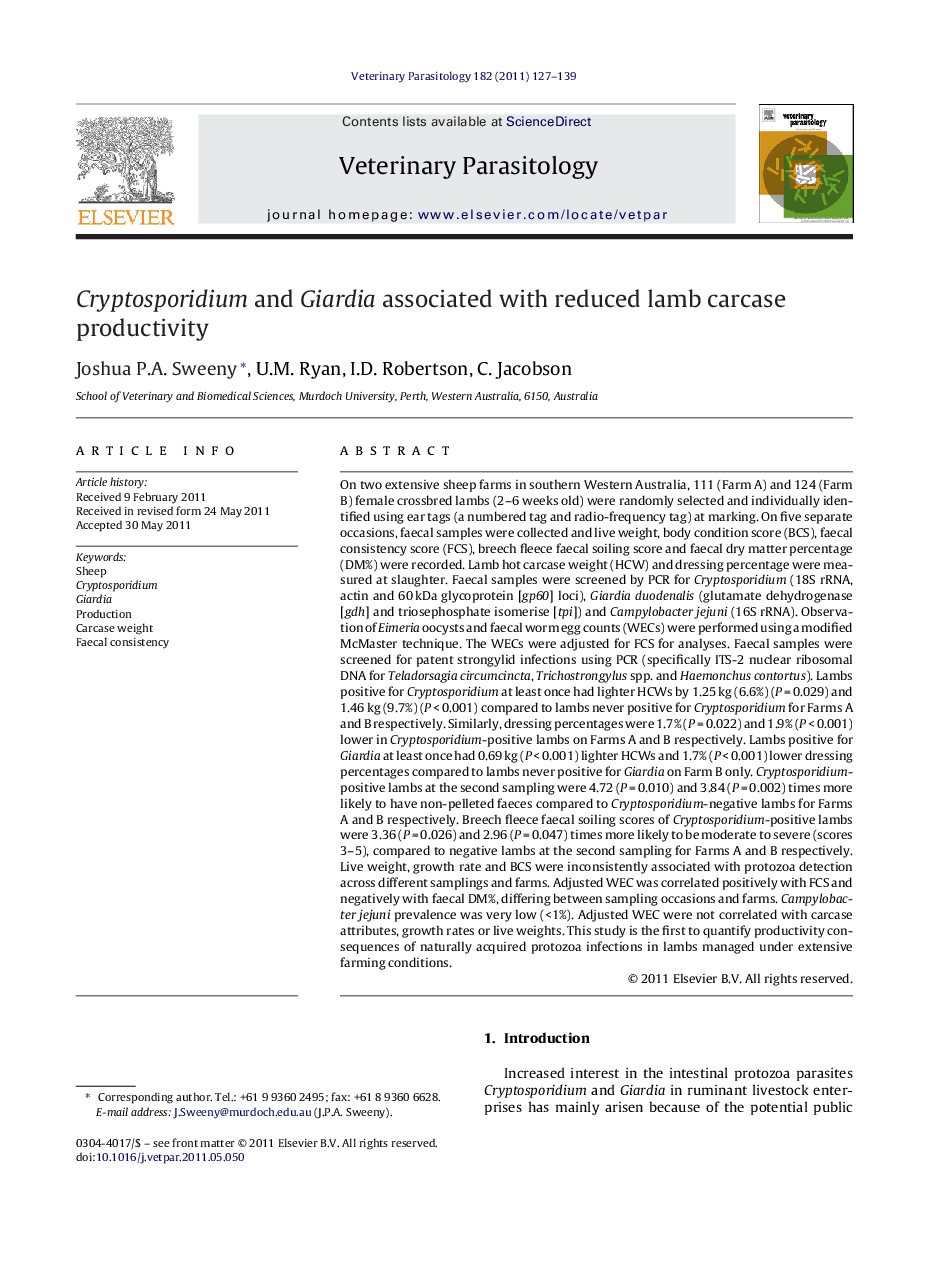| کد مقاله | کد نشریه | سال انتشار | مقاله انگلیسی | نسخه تمام متن |
|---|---|---|---|---|
| 5805605 | 1555720 | 2011 | 13 صفحه PDF | دانلود رایگان |

On two extensive sheep farms in southern Western Australia, 111 (Farm A) and 124 (Farm B) female crossbred lambs (2-6 weeks old) were randomly selected and individually identified using ear tags (a numbered tag and radio-frequency tag) at marking. On five separate occasions, faecal samples were collected and live weight, body condition score (BCS), faecal consistency score (FCS), breech fleece faecal soiling score and faecal dry matter percentage (DM%) were recorded. Lamb hot carcase weight (HCW) and dressing percentage were measured at slaughter. Faecal samples were screened by PCR for Cryptosporidium (18S rRNA, actin and 60Â kDa glycoprotein [gp60] loci), Giardia duodenalis (glutamate dehydrogenase [gdh] and triosephosphate isomerise [tpi]) and Campylobacter jejuni (16S rRNA). Observation of Eimeria oocysts and faecal worm egg counts (WECs) were performed using a modified McMaster technique. The WECs were adjusted for FCS for analyses. Faecal samples were screened for patent strongylid infections using PCR (specifically ITS-2 nuclear ribosomal DNA for Teladorsagia circumcincta, Trichostrongylus spp. and Haemonchus contortus). Lambs positive for Cryptosporidium at least once had lighter HCWs by 1.25Â kg (6.6%) (PÂ =Â 0.029) and 1.46Â kg (9.7%) (PÂ <Â 0.001) compared to lambs never positive for Cryptosporidium for Farms A and B respectively. Similarly, dressing percentages were 1.7% (PÂ =Â 0.022) and 1.9% (PÂ <Â 0.001) lower in Cryptosporidium-positive lambs on Farms A and B respectively. Lambs positive for Giardia at least once had 0.69Â kg (PÂ <Â 0.001) lighter HCWs and 1.7% (PÂ <Â 0.001) lower dressing percentages compared to lambs never positive for Giardia on Farm B only. Cryptosporidium-positive lambs at the second sampling were 4.72 (PÂ =Â 0.010) and 3.84 (PÂ =Â 0.002) times more likely to have non-pelleted faeces compared to Cryptosporidium-negative lambs for Farms A and B respectively. Breech fleece faecal soiling scores of Cryptosporidium-positive lambs were 3.36 (PÂ =Â 0.026) and 2.96 (PÂ =Â 0.047) times more likely to be moderate to severe (scores 3-5), compared to negative lambs at the second sampling for Farms A and B respectively. Live weight, growth rate and BCS were inconsistently associated with protozoa detection across different samplings and farms. Adjusted WEC was correlated positively with FCS and negatively with faecal DM%, differing between sampling occasions and farms. Campylobacter jejuni prevalence was very low (<1%). Adjusted WEC were not correlated with carcase attributes, growth rates or live weights. This study is the first to quantify productivity consequences of naturally acquired protozoa infections in lambs managed under extensive farming conditions.
Journal: Veterinary Parasitology - Volume 182, Issues 2â4, 15 December 2011, Pages 127-139